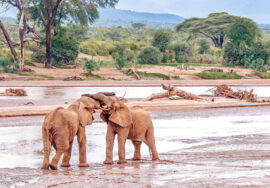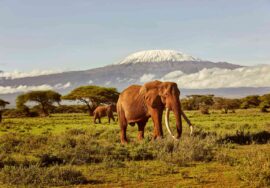
MERU NATIONAL PARK
Meru National Park
Location
Meru National Park lies to the east of the town of Meru, within Meru County, in northern Kenya. The park is situated approximately 220 miles northeast of Nairobi, making it a remote yet accessible destination for safari enthusiasts.
Size
The total area of Meru National Park encompasses about 340 square miles, offering ample space for a wide variety of habitats and wildlife to flourish in their natural state.
History
Meru National Park experienced a strong revival in the early 2000s, with restoration efforts undertaken between 2000 and 2005. The park’s rejuvenation was significantly supported by the International Fund for Animal Welfare, leading to enhanced protection and infrastructure. In 2005, the park was recognized as a part of the prestigious “Lion Conservation Unit,” cementing its importance in the conservation of Africa’s iconic predators.
Entrance Fees & Permits
The entry fee into Meru National Park is USD 52 per adult and USD 35 per child under the age of 12. These fees are valid for a period of 24 hours, allowing visitors full access to the park’s activities and amenities during that time.
Hours of Operation
The gates of Meru National Park are open daily from 6:00 am to 6:00 pm, giving guests the opportunity to enjoy early morning and late afternoon safari experiences during prime wildlife viewing hours.
How to Get There
By Road
Meru National Park is about 220 miles from Nairobi, a drive that typically takes around six hours. The journey northeast follows the Nairobi Highway/A2 and transitions onto the Nairobi-Meru Highway/B6. The park can be accessed through two primary entry gates—Murera Gate and Ura Gate.
By Air
Air travel offers a faster route, with flights from Nairobi’s Wilson Airport taking approximately 65 minutes. Covering a distance of roughly 216 miles, the flight lands visitors closer to the park for a seamless transition into their wilderness experience.
Best Time to Visit
Weather & Climate
Meru National Park maintains a relatively mild climate throughout the year, with average temperatures reaching up to 90°F. The coolest and driest months—June, July, and August—are considered the best for wildlife viewing. November brings the heaviest rainfall, while March is typically the hottest month. May is celebrated for its abundant sunshine and scenic beauty.
Avoiding Crowds
For those seeking a more exclusive experience, visiting just before or after the high season is ideal. October and early November offer fewer tourists and excellent wildlife sightings. Similarly, May and early June present sunny days, cooler weather, and sparse crowds—making it an excellent time to explore the park in peace.
Value for Money
Meru National Park offers a broad range of accommodation options to suit various budgets. Comfortable camps begin at around USD 270 per person per night, while luxury lodges may range between USD 750 and USD 1,400 per person sharing per night. The park’s remoteness ensures a more private and exclusive safari experience, offering excellent value for money compared to more crowded destinations.
Wildlife and Landscape
Popular Wildlife Sightings in Meru National Park
Meru National Park is a sanctuary for Africa’s famed “Big Five”—lion, leopard, rhino, elephant, and buffalo. Guests can also spot cheetah lounging under shady trees, giraffe grazing gracefully, and antelope species such as kudu and dik-dik. The Somali ostrich and the common zebra are frequently seen at watering holes. Birdwatchers will be captivated by the park’s extraordinary avian diversity, with over 420 recorded bird species found in the region.
The Terrain
The terrain of Meru National Park is both rugged and diverse. Expansive grasslands are juxtaposed with dense forests and acacia-dotted savannahs. Several rivers—most notably the Tana, Rojeweru, and Ura Rivers—meander through the park, along with numerous small streams. The presence of anthills scattered among the vegetation and a backdrop of distant mountains gives the park an untouched, wild feel that few other destinations can match.
Experiences
Game Drives
Game drives are conducted in specially designed 4×4 vehicles, often beginning early in the morning or during the late afternoon. These times coincide with peak animal activity and allow guests the best opportunities to witness predators on the hunt or large herds gathering at watering points. The expertise of professional guides adds tremendous value to the experience, sharing knowledge about animal behavior and the ecosystem. Some lodges offer night game drives using open vehicles, enhancing the thrill with potential sightings of nocturnal wildlife like hyenas, leopards, and bush babies.
Guided Walking Safaris
For those desiring a more intimate encounter with nature, guided walking safaris provide an immersive perspective. Led by highly trained guides, these walks usually last around one hour and focus on the smaller intricacies of the bush—animal tracks, plants, insects, and birds that might go unnoticed from a vehicle. The excitement of being on foot in such a vast and wild area brings a profound sense of connection to the land and its creatures. Walking through the African wilderness offers an authentic and enriching Kenya safari experience.
Meru National Park remains one of Kenya’s best-kept secrets. Its breathtaking landscapes, abundant wildlife, and lower tourist density ensure that each safari feels personal and unforgettable. Whether admiring lions in the tall grass, listening to birdsong along the riverbanks, or feeling the thrill of tracking animals on foot, Meru offers a raw and deeply rewarding encounter with nature.
For expertly curated itineraries and seamless safari logistics, travelers are encouraged to book their African tours and adventures through Adventure In The Wild Safaris. Their in-depth local knowledge and commitment to exceptional service ensure that every guest enjoys a journey of discovery and wonder, tailored to create lifelong memories in the wild heart of Africa.








